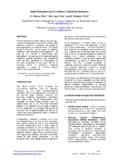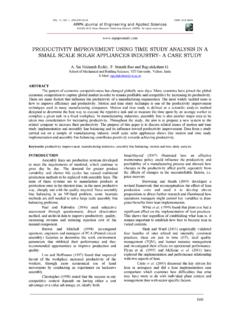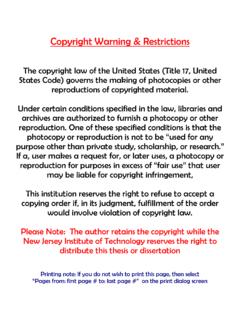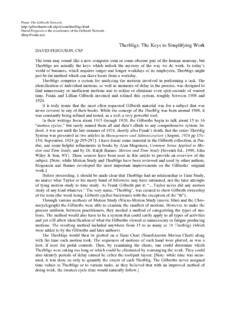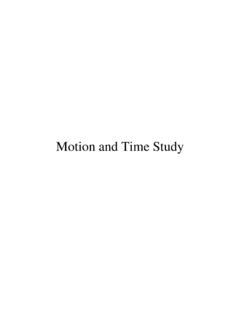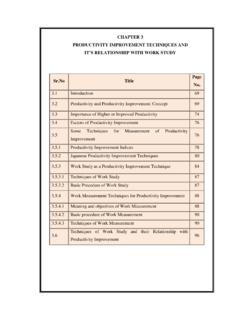Transcription of A Case Study Application of Time Study Model in …
1 A Case Study Application of time Study Model in an Aluminum Company Oke, Department of Mechanical Engineering, University of Lagos, Nigeria * E-mail: ABSTRACT This paper presents a case Study in the development and Application of a time Study Model in a hollowware aluminium manufacturing plant. The organization engages in the production of three product lines: kettles, frying pans, and cooking pots of diverse categories. The motivation for this Study was the need to intervene in frequent crises that normally arose between the employee-association and the management of the company regarding questions of productivity. The three products have similar production processes. Hence, the method of breaking down the processes into jobs and tasks was adopted and analyzed through the use of differential calculus.
2 This method was applied to the manufacturing processes with the kettle production system drawn as an example. The kettle production process consists of several major activities including stamping and oiling, press forming, trimming, spinning, degreasing, polishing, labelling, wiping and wrapping, spout holing and bumping, inspection, riveting, and packing. By understanding and applying the Model , managers can logically trace the effects of time wastages on the production output of systems and their effects. The Study s most important finding is that the time of producing a unit of product is directly proportional to the number of production stages involved and the time spent at each stage. This can be represented by some structural equations, which are characteristics of the system being studied.
3 The limitations of the Study lie in the variability of the major components of the system. The Model does not incorporate some variables which may influence decisions made based on the computation of time for which the Model may be used. (Keywords: manufacturing, process analysis, efficiency Study , time Study , management analysis, differential calculus, mathematical modelling) INTRODUCTION Research on time Study incorporates a range of concerns, including its definition and management (Edo et al., 2001; Worrall and Smith, 1985; Watson, 1988; Aft, 2000). Although research on work measurement has evolved in a scientific and rigorous fashion, based on early works of Gilbert and others, the quantitative mathematical modelling of production activities in terms of time Study has not evolved in a similarly rigorous fashion (Barnes, 1980; Zandin, 2003; Doty, 1989; Karger and Bayha, 2003).
4 In recent years, the manufacturing organization used as the case example in this work has realized that scientific approaches could be developed to aid dispute settlement between the employees association of the company and management regarding issues of productivity. In order to achieve this, the company was motivated to approach a management consultant. This paper is an attempt to present the methodology used in solving productivity issues at this company. The aluminium company of concern has a manufacturing unit in Lagos, Nigeria. The company stocks various products and distributes them to consumers on order. The company representatives are engaged in the sales of the products. The company concentrates on the manufacture of three fast-moving items kettles, pots, and frying pans.
5 The operations are housed in a large factory floor consisting of several manufacturing machines, each of which costs an equivalent of several thousand Euros/Dollars. The products are produced in categories. For example, kettles could be of the general form ( 4, 6, 8, 12 pint), tea pot kettle ( pint), globe kettle (4 or 6 pint), folding hand kettle ( 4 or 6 pint), Bakelite handle kettle (6 pint), or electric kettle (6 or 8 pint). Cooking pots (usually referred to as casseroles) are of different groupings. This includes sets of 4 or 5 or larger sets of 2. There are also round bottom pots as well as stew pans (6" diameter). In addition, the company sells The Pacific Journal of Science and Technology 153 Volume 7. Number 2. November 2006 (Fall) quality ware or special quality ware.
6 Frying pans are specified by handle type. They could be fry pans with steel handles, Bakelite, quality ware, or deep quality ware (painted or plain). An important problem faced in the hollowware production system is that of determining the time it takes to produce a unit of product. In order to thoroughly analyze the problem, the production processes for each of kettle, pots, and frying pans were examined (Figure 1). Kettle production activities could be broken down into 14 steps: stamping and oiling, press forming, trimming, spinning, degreasing, post degreasing, polishing, labelling, wiping and wrapping, spout bumping (manual and hydraulic), inspection, riveting, and packing. In the production of kettles, two processes are involved. The above process is the first stage that relates to the production of the body, while the second stage relates to the production of the kettle lid.
7 In particular, six activities are involved in the manufacture of the kettle lid: press forming, swaging and perforating, polishing, knobbing, inside wiping, surface wiping and packaging. Figure 1: The Production Process for a Cooking Pot. The production of cooking pots consists of twelve steps. These are oiling, press forming, trimming, degreasing, polishing, inside wiping, sun raying, piercing, riveting, stamping, surface wiping and logo pasting. The production of lids for the pots is similar to that of kettle. The process for producing a frying pan is slightly different from the two processes discussed above in that the piercing activities are further broken down into two runs ( 1st and 2nd piercing). Thus, the nine-stage process is press forming, trimming, degreasing, surface sun raying, inside sun raying, 1st piercing, 2nd piercing, riveting, and packing.
8 THE time Study Model Several types of information need to be declared in order to have a background understanding into the problem, its formulation, and solution. This would also guide practicing managers who may be in the same and similar systems, and who are willing to apply the Model . From the information obtained at the factory floor, the production system is effective. It infers that no losses or leakages are in the production system. Thus, all the efforts put into the production system would yield the desired results. A second information type obtained from the production system is that the right calibre of production personnel is involved. For example, if a worker is of lower skill than required and is engaged in production activities, low or sub-optimal results may be obtained. The right skill, knowledge, and technical know-how of workers is therefore required.
9 A third information category is that there is a defined responsibility for an individual production worker. Hence, a production target is in place, and could be monitored. An added information set is that machines are always in a heavy state. This means that the time Study Model proposed applies only to a full operational season for the system. Hence, in a real calculation of units produced, the equivalent units lost due to down time many have to be subtracted from the total possible units to be produced. It is noted that when a machine breaks down it can always be repaired and restored in a negligible true frame. There is a clear definition and measurement of output, hence the unit of measurement of production output is known and specified. It is assumed that no significant product damage is allowed during the production process.
10 Any damage is assumed to be either during the parking period or time of logistics. An added information set is that the allowance periods (break, idle time , recess, etc.) for all of the departments for production are the same. In the modelling process, the stating point is to identify the various units of production. As a research strategy and for the ease of computation, only analyses relevant to kettle production are presented here. The process of producing a The Pacific Journal of Science and Technology 154 Volume 7. Number 2. November 2006 (Fall) kettle is clearly divided into sixteen steps; stamping and oiling, press forming, trimming, spinning, degreasing, post degreasing, polishing, labelling, wiping and wrapping, spout hole piercing, spout bumping (manual), spout bumping (hydraulic), inspection 1, riveting, inspection 2, and packing.

